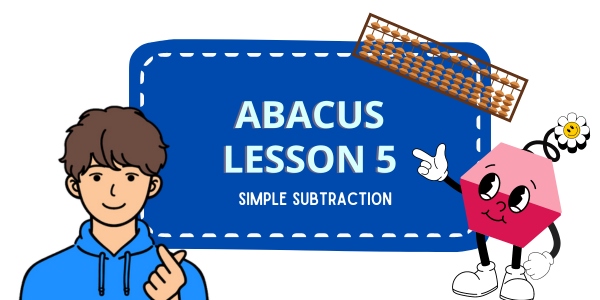
Welcome to Abacus Lesson 5!
In our last lesson, we learned how to add numbers using the abacus. Remember sliding those beads towards the bar? That’s how we add—they turn into numbers! And don’t forget, it’s crucial to place each number in the right column on the abacus, according to its place value.
Now, let’s shift our focus to subtraction. Today, we’ll start by subtracting numbers without borrowing in the ones place column. We’ll keep it simple so you can see how subtraction works on the abacus. We will explore the details of the finger movements – thumb, pointer, and thumb+pointer – which you’ve already become acquainted with in the previous lesson.
Mastering addition and subtraction, while placing numbers correctly, is crucial for solid arithmetic skills. Ready to dive back in? Let’s get started!

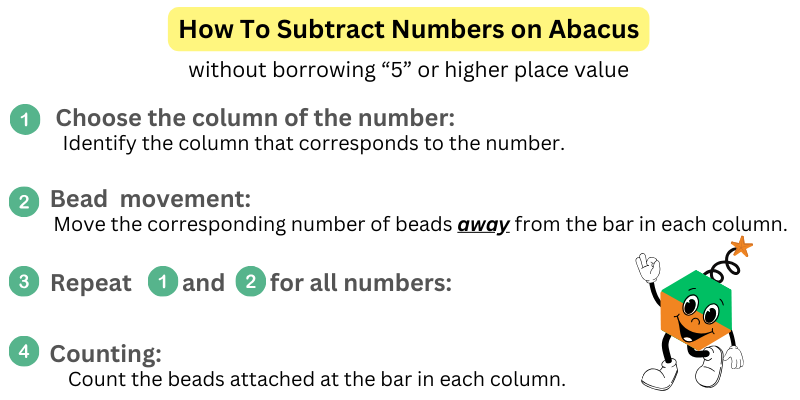

Let’s go through some examples using the table above. You’ll see how we subtract on the abacus by finding the right column, moving beads, doing the steps again, and counting.
Simple subtraction in the ones place column
Example 1: [3 - 2]
- Choose the colum of the first number: The first number is 3. It’s a single digit number, so we will add 3 in the ones place column.
- Bead Movement: Move 3 lower beads up toward the bar.
- Choose the column of the second number: The second number is 2. It’s also a single digit number. We will subtract 2 in the same ones place column.
- Bead Movement: Move 2 lower beads away from the bar.
- Count the number of beads attached at the bar to determine the sum. 1 lower bead is attached to the bar.
Thus, the answer is 1. 3-2=1.
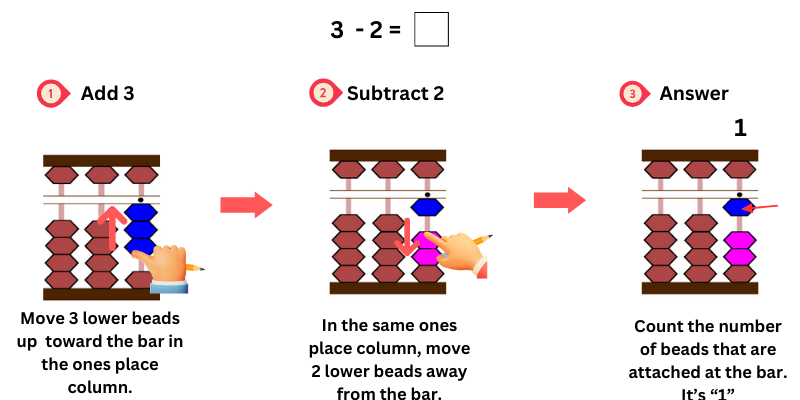

Example 2: [8 - 5]
- Choose the colum of the first number: The first number is 8. It’s a single digit number, so we will add 8 in the ones place column.
- Bead Movement: Move the upper bead and 3 lower beads up toward the bar.
- Choose the column of the second number: The second number is 5. It’s also a single digit number. We will subtract 5 in the same ones place column.
- Bead Movement: Move the upper bead away from the bar.
- Count the number of beads attached at the bar to determine the sum. Each lower bead has a value of 1, and 3 lower beads are attached to the bar. Thus, the answer is 3. 8-5=3.
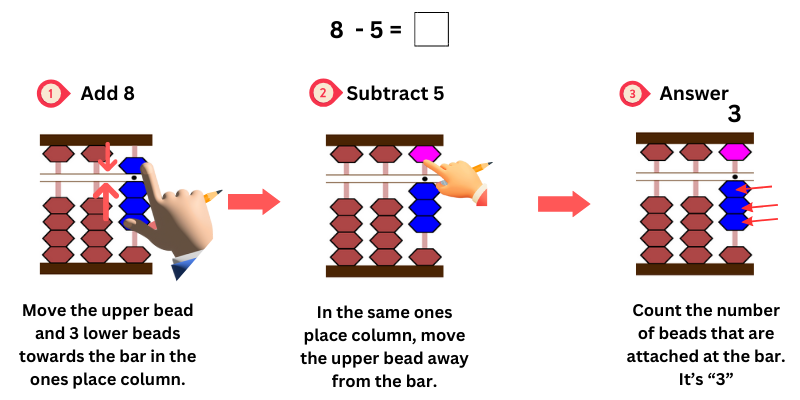

Example 3: [8 - 6]
- Choose the colum of the first number: The first number is 8. It’s a single digit number, so we will add 8 in the ones place column.
- Bead Movement: Move the upper bead and 3 lower beads up toward the bar.
- Choose the column of the second number: The second number is 6. It’s also a single digit number. We will subtract 6 in the same ones place column.
- Bead Movement: Move 1 lower bead away from the bar. Then move the upper bead away from the bar (You may subtract the upper bead and 1 lower bead simultaneously).
- Count the number of beads attached at the bar to determine the sum. Each lower bead has a value of 1, and 2 lower beads are attached to the bar. Thus, the answer is 2. 8-6=2.
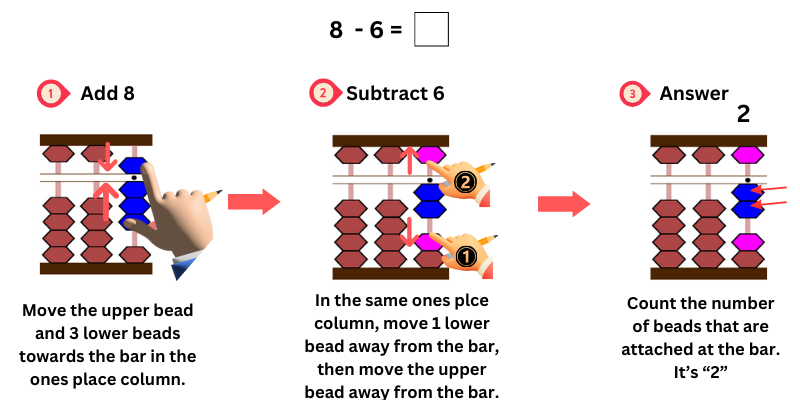

Video Lesson for Simple Subtraction

Simple Subtractions with 3 Numbers
When adding and subtracting 3 or more numbers on the abacus, you follow the same steps as adding two numbers. For each number, locate its column and move the corresponding lower beads or/and upper bead towards the bar for adding. Move the corresponding lower beads or/and upper bead away from the bar for subtracting. Repeat this for each number. Once done, count the beads to find the total sum. It’s a simple and consistent process that makes multi-number addition and subtraction easy on the abacus.
Example 4: [9 - 6 - 2 ]
- Choose the colum of the first number: The first number is 9. It’s a single digit number, so we will add 9 in the ones place column.
- Bead Movement: Move the upper bead and 4 lower beads toward the bar.
- Choose the column of the second number: The second number is 6. It’s also a single digit number. We will subtract 6 in the same ones place column.
- Bead Movement: Move 1 lower bead away from the bar, then move the upper bead away from the bar (You may subtract the upper bead and the lower bead simultaneously).
- Choose the column of the third number: The third number is 2. It’s also a single digit number. We will subtract 2 in the same ones place column.
- Bead Movement: Move 2 lower beads away from the bar.
- Count the number of beads attached at the bar to determine the sum. There is 1 lower bead attached at the abar. Thus, the answer is 1. 9-6-2=1.
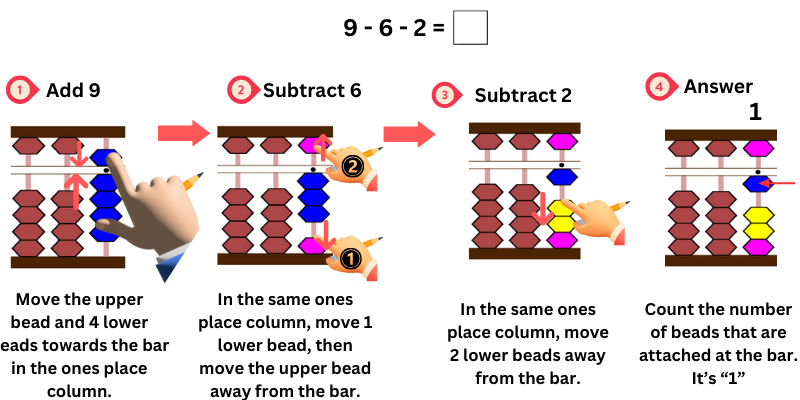

Practice Questions
Work through all the worksheet or video problems multiple times until you feel confident with simple subtraction. Pay attention to using the right fingers for each operation. Consistent practice will enhance your skills.
Click the green button below to access the printable worksheets.
Click the video below to access the video practice questions.


In this lesson, we delved into subtracting numbers with the abacus. Remember, when you move the beads away from the bar, that’s subtraction in action! Just like with addition, it’s crucial to pick the correct column for the number you’re subtracting.
Since we stuck to single-digit numbers in this lesson, we mainly worked with the ones place column. You just keep adding or subtracting in that column until you’ve either used up all the beads for adding or don’t have enough beads to subtract.
Next up, we’ll level up and tackle addition and subtraction with multi-digit numbers, all without any carrying over or borrowing. But don’t worry, we’ll keep things just as straightforward as the single-digit operations. The key? Stay focused on choosing the right place column.
Are you ready to take the next step? Let’s dive into the next lesson together!
